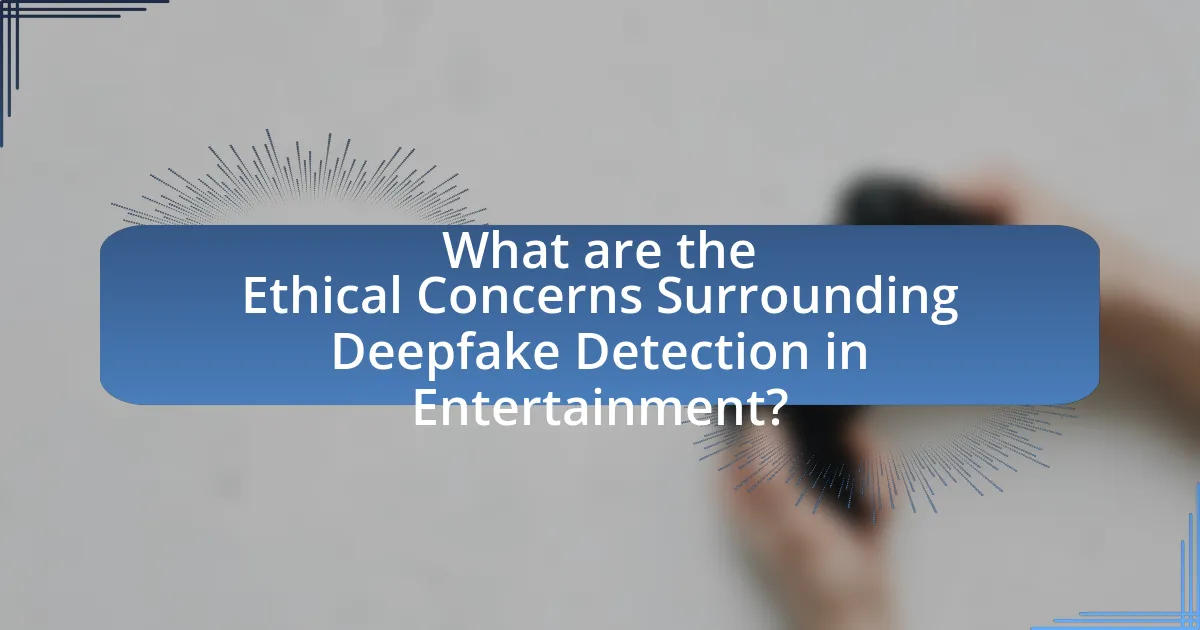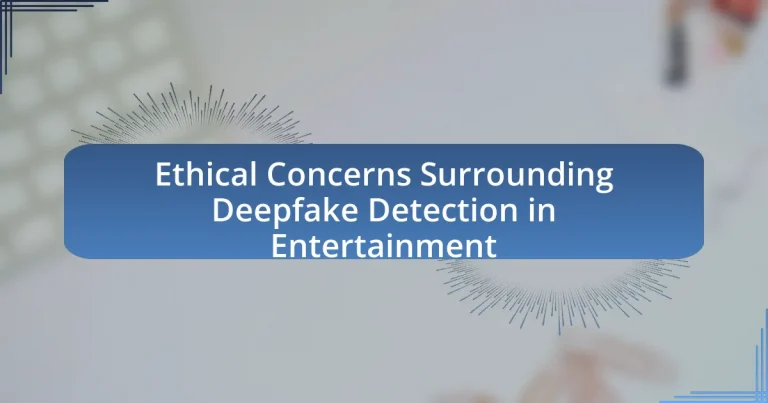The article examines the ethical concerns surrounding deepfake detection in the entertainment industry, focusing on issues such as consent, misinformation, and reputational harm. It highlights the risks associated with unauthorized use of individuals’ likenesses, the potential for deepfakes to distort public perception, and the erosion of trust in media. The discussion includes the effectiveness and limitations of current deepfake detection technologies, the ethical dilemmas they present, and the importance of establishing robust regulatory frameworks and best practices to navigate these challenges. Additionally, it emphasizes the need for collaboration among industry stakeholders to address the implications of deepfake technology effectively.

What are the Ethical Concerns Surrounding Deepfake Detection in Entertainment?
The ethical concerns surrounding deepfake detection in entertainment primarily involve issues of consent, misinformation, and the potential for harm to individuals’ reputations. Consent is critical, as deepfakes can be created without the knowledge or approval of the individuals depicted, leading to unauthorized use of their likenesses. Misinformation arises when deepfakes are used to manipulate narratives or create false representations, which can mislead audiences and distort public perception. Additionally, the potential for reputational harm is significant, as individuals may find themselves associated with content they did not endorse or participate in, leading to personal and professional repercussions. These concerns highlight the need for robust ethical guidelines and detection technologies to mitigate the risks associated with deepfake content in the entertainment industry.
Why is deepfake technology a concern in the entertainment industry?
Deepfake technology is a concern in the entertainment industry because it can be used to create misleading and harmful content that undermines trust in media. This technology allows for the manipulation of video and audio to produce realistic but fabricated representations of individuals, which can lead to issues such as identity theft, defamation, and the spread of misinformation. For instance, a study by the University of California, Berkeley, found that deepfakes can significantly impact public perception and trust, as they can be indistinguishable from genuine content. Additionally, the potential for deepfakes to be used in non-consensual pornography raises serious ethical questions regarding consent and exploitation in the industry.
What potential harms can deepfakes cause to individuals and society?
Deepfakes can cause significant harms to individuals and society by facilitating misinformation, damaging reputations, and undermining trust in media. Misinformation can lead to the spread of false narratives, as seen in instances where deepfakes have been used to create misleading political content, influencing public opinion and electoral outcomes. Additionally, individuals can suffer reputational damage when deepfakes are used to create non-consensual explicit content, leading to emotional distress and social stigma. The erosion of trust in media is evidenced by studies indicating that the prevalence of deepfakes can make it increasingly difficult for people to discern real from fake content, contributing to a general skepticism towards legitimate news sources.
How can deepfakes impact public trust in media?
Deepfakes can significantly undermine public trust in media by creating realistic but fabricated content that misleads audiences. The proliferation of deepfake technology has made it increasingly difficult for individuals to discern between authentic and manipulated media, leading to skepticism about the credibility of news sources. A study by the Pew Research Center found that 51% of Americans believe fabricated news stories cause confusion about the facts, illustrating the widespread concern regarding misinformation. As deepfakes become more sophisticated, the potential for misuse in political, social, and entertainment contexts raises ethical dilemmas, further eroding trust in media institutions.
What ethical dilemmas arise from the use of deepfake technology?
The use of deepfake technology raises significant ethical dilemmas, primarily concerning misinformation, consent, and potential harm. Misinformation arises when deepfakes are used to create false narratives, misleading audiences and damaging reputations, as evidenced by instances where manipulated videos have influenced public opinion or political outcomes. Consent issues emerge when individuals’ likenesses are used without permission, violating personal rights and autonomy, particularly in cases where deepfakes are employed in adult content or defamatory contexts. Additionally, the potential for harm is evident in scenarios where deepfakes can incite violence or harassment, as seen in targeted attacks on individuals through fabricated media. These ethical concerns highlight the need for regulatory frameworks to address the implications of deepfake technology in entertainment and beyond.
How does consent play a role in the creation of deepfakes?
Consent is crucial in the creation of deepfakes as it determines the ethical legitimacy of using an individual’s likeness or voice. When creators of deepfakes obtain consent from the individuals being depicted, they respect personal autonomy and legal rights, thereby reducing the potential for harm or exploitation. Conversely, creating deepfakes without consent can lead to significant ethical violations, including defamation, privacy invasion, and emotional distress for the individuals involved. Legal frameworks, such as copyright and personality rights, often require consent to use someone’s image or voice, reinforcing the importance of this principle in the deepfake context.
What are the implications of using someone’s likeness without permission?
Using someone’s likeness without permission can lead to legal repercussions, including lawsuits for invasion of privacy and misappropriation of likeness. The unauthorized use of an individual’s image can violate their rights, resulting in financial damages and potential injunctions against further use. For instance, in the case of the 2018 lawsuit against the creators of a deepfake video featuring a celebrity, the court ruled in favor of the celebrity, emphasizing the importance of consent in likeness usage. Additionally, ethical concerns arise regarding the potential for harm to an individual’s reputation and the exploitation of their identity for profit without compensation.
How does deepfake detection technology address these ethical concerns?
Deepfake detection technology addresses ethical concerns by providing tools to identify manipulated media, thereby protecting individuals from misinformation and unauthorized use of their likeness. This technology employs advanced algorithms and machine learning techniques to analyze videos and images for inconsistencies that indicate deepfake manipulation. For instance, a study published in the journal “Nature” by Korshunov and Marcel in 2018 demonstrated that deepfake detection systems could achieve over 90% accuracy in identifying altered content. By ensuring the authenticity of media, these detection systems help uphold trust in digital communications and mitigate the potential for harm associated with deepfakes, such as defamation or fraud.
What methods are used in deepfake detection?
Deepfake detection employs various methods, including machine learning algorithms, visual artifacts analysis, and biometric recognition techniques. Machine learning algorithms, particularly convolutional neural networks (CNNs), are trained on large datasets of real and fake videos to identify subtle discrepancies that human viewers may overlook. Visual artifacts analysis focuses on detecting inconsistencies in lighting, shadows, and facial movements that are often present in deepfakes. Biometric recognition techniques analyze unique facial features and expressions to differentiate between genuine and manipulated content. These methods are supported by research, such as the study by Korshunov and Marcel (2018), which demonstrated the effectiveness of CNNs in distinguishing deepfake videos from authentic ones, highlighting the importance of advanced detection techniques in combating misinformation in entertainment.
How effective are current detection technologies in identifying deepfakes?
Current detection technologies are moderately effective in identifying deepfakes, with accuracy rates varying based on the specific algorithms used. Research indicates that state-of-the-art deepfake detection methods can achieve accuracy levels exceeding 90% in controlled environments, but their effectiveness diminishes in real-world scenarios due to the evolving sophistication of deepfake generation techniques. For instance, a study published in 2020 by the University of California, Berkeley, demonstrated that while detection algorithms could identify 95% of deepfakes in a dataset, they struggled with new, unseen variations, highlighting the ongoing arms race between deepfake creation and detection technologies.
What are the limitations of deepfake detection technologies?
Deepfake detection technologies face several limitations, primarily due to the rapid advancement of deepfake creation techniques. These technologies often struggle to keep pace with increasingly sophisticated algorithms that generate hyper-realistic content, making it difficult to identify manipulated media accurately. For instance, a study published in 2020 by the University of California, Berkeley, highlighted that detection systems could only achieve around 65% accuracy on certain deepfake datasets, indicating a significant margin for error. Additionally, deepfake detection tools may be biased towards specific types of content or formats, limiting their effectiveness across diverse media. Furthermore, the reliance on machine learning models means that they require extensive training data, which may not always be available or representative of all potential deepfake scenarios.
How do advancements in deepfake creation challenge detection efforts?
Advancements in deepfake creation significantly challenge detection efforts by increasing the sophistication and realism of manipulated media. As deepfake technology evolves, it employs advanced machine learning techniques, such as generative adversarial networks (GANs), which produce highly convincing audio and visual content that can easily deceive both human viewers and automated detection systems. For instance, a study by the University of California, Berkeley, found that state-of-the-art deepfake algorithms can generate videos that are indistinguishable from real footage, complicating the identification process for detection tools that rely on traditional methods. Consequently, the rapid improvement in deepfake quality outpaces the development of effective detection algorithms, leading to a growing concern about misinformation and ethical implications in entertainment and beyond.
What ethical considerations arise from the limitations of detection technologies?
The ethical considerations arising from the limitations of detection technologies include the potential for misinformation, invasion of privacy, and the erosion of trust in media. Misinformation can occur when detection technologies fail to accurately identify deepfakes, leading to the spread of false narratives. For instance, a study by the University of California, Berkeley, highlighted that inaccurate detection can result in the public being misled by manipulated content, which undermines informed decision-making. Invasion of privacy is another concern, as detection technologies may require access to personal data to function effectively, raising issues about consent and data security. Furthermore, the erosion of trust in media is significant; as detection technologies become less reliable, audiences may become skeptical of all media content, regardless of its authenticity, as noted in research published in the Journal of Media Ethics. These ethical considerations underscore the need for robust and transparent detection technologies to mitigate their limitations.
How can the entertainment industry navigate ethical concerns related to deepfakes?
The entertainment industry can navigate ethical concerns related to deepfakes by implementing strict regulations and guidelines for their use. Establishing clear policies that define acceptable and unacceptable uses of deepfake technology can help protect individuals’ rights and prevent misuse. For instance, the industry can adopt consent-based frameworks where actors and public figures must provide explicit permission before their likeness is used in deepfake content. Additionally, transparency in the creation and distribution of deepfakes can be enforced, ensuring that audiences are informed when they are viewing manipulated content. Research indicates that ethical frameworks, such as those proposed by the Digital Media Association, emphasize the importance of accountability and respect for personal identity in digital media. By adhering to these principles, the entertainment industry can mitigate ethical risks associated with deepfakes while fostering innovation.
What best practices should be implemented for ethical deepfake use?
Best practices for ethical deepfake use include obtaining explicit consent from individuals whose likenesses are used, ensuring transparency about the use of deepfake technology, and implementing clear labeling to distinguish deepfakes from genuine content. Explicit consent is crucial as it respects individual rights and privacy, while transparency fosters trust among audiences. Labeling deepfakes helps mitigate misinformation and allows viewers to critically assess the content. These practices align with ethical standards in media and communication, as highlighted by the Digital Media Ethics framework, which emphasizes accountability and respect for individuals’ autonomy in digital representations.
How can industry stakeholders collaborate to address these ethical issues?
Industry stakeholders can collaborate to address ethical issues surrounding deepfake detection in entertainment by establishing cross-sector partnerships that include technology developers, content creators, legal experts, and ethicists. These collaborations can lead to the development of standardized ethical guidelines and best practices for the use of deepfake technology, ensuring transparency and accountability. For instance, the creation of a consortium that includes major film studios and AI companies can facilitate the sharing of knowledge and resources, enabling the development of robust detection tools that respect artistic integrity while protecting against misuse. Additionally, joint initiatives can promote public awareness and education about the implications of deepfakes, fostering a more informed audience that can critically engage with content.
What are the future implications of deepfake technology in entertainment?
The future implications of deepfake technology in entertainment include enhanced storytelling and character development, as well as significant ethical challenges. As deepfake technology advances, filmmakers may utilize it to create realistic digital doubles, allowing for innovative narratives and the resurrection of deceased actors in new roles. However, this capability raises ethical concerns regarding consent, authenticity, and the potential for misinformation. For instance, a study by the University of California, Berkeley, highlights that 96% of respondents expressed concern over the misuse of deepfake technology in media, indicating a strong public awareness of its implications. Thus, while deepfake technology can revolutionize entertainment, it simultaneously necessitates robust ethical frameworks to address the associated risks.
How might evolving deepfake technology shape ethical standards in the industry?
Evolving deepfake technology is likely to necessitate the establishment of stricter ethical standards within the entertainment industry. As deepfakes become increasingly sophisticated, the potential for misuse—such as creating misleading or harmful content—grows, prompting industry stakeholders to prioritize ethical guidelines. For instance, the rise of deepfake videos has already led to discussions about consent, authenticity, and the potential for defamation, which are critical issues that require clear ethical frameworks. The need for accountability in content creation is underscored by incidents where deepfakes have been used to manipulate public perception, highlighting the urgency for the industry to adapt its ethical standards to safeguard against such abuses.
What role will regulation play in managing deepfake technology?
Regulation will play a crucial role in managing deepfake technology by establishing legal frameworks that define acceptable use and penalize malicious applications. These regulations can help mitigate risks associated with misinformation, identity theft, and privacy violations, which are prevalent issues linked to deepfakes. For instance, countries like the United States and the European Union are already considering or implementing laws that specifically address the creation and distribution of deepfake content, aiming to protect individuals and maintain public trust in media. Such regulatory measures can include mandatory disclosures for deepfake content and penalties for misuse, thereby promoting ethical standards in the entertainment industry and beyond.
What practical steps can individuals take to understand and respond to deepfake ethics?
Individuals can take several practical steps to understand and respond to deepfake ethics. First, they should educate themselves about the technology behind deepfakes, including how they are created and the potential implications for misinformation and consent. Engaging with reputable sources, such as academic articles and expert talks, can provide a solid foundation of knowledge.
Second, individuals can participate in discussions and forums focused on digital ethics, which can enhance their understanding of the societal impacts of deepfakes. For instance, organizations like the Partnership on AI offer resources and events that address these ethical concerns.
Third, individuals should advocate for and support legislation that addresses the misuse of deepfake technology, as legal frameworks can help mitigate ethical violations. Research indicates that legal measures can deter malicious uses of deepfakes, as seen in states like California, which has enacted laws specifically targeting deepfake-related harms.
Lastly, individuals can develop critical media literacy skills to better discern authentic content from manipulated media. This includes learning to recognize signs of deepfakes and understanding the broader context in which they are used. By taking these steps, individuals can contribute to a more informed and ethical discourse surrounding deepfake technology.


